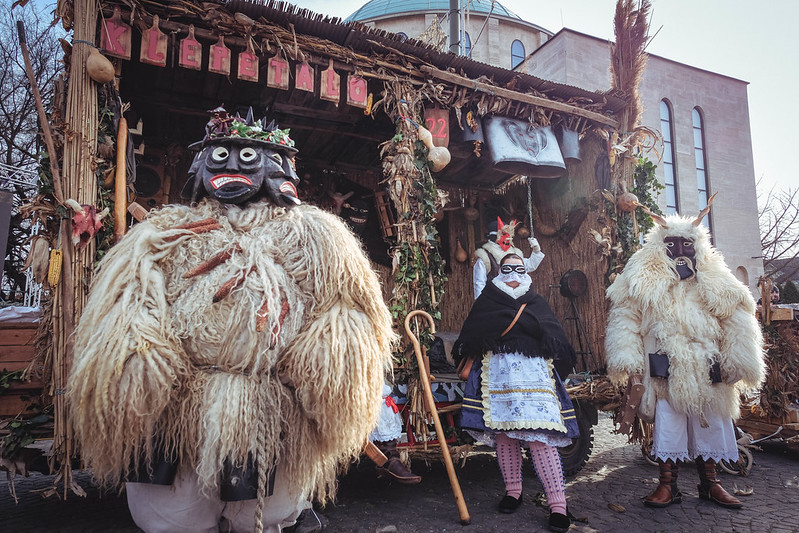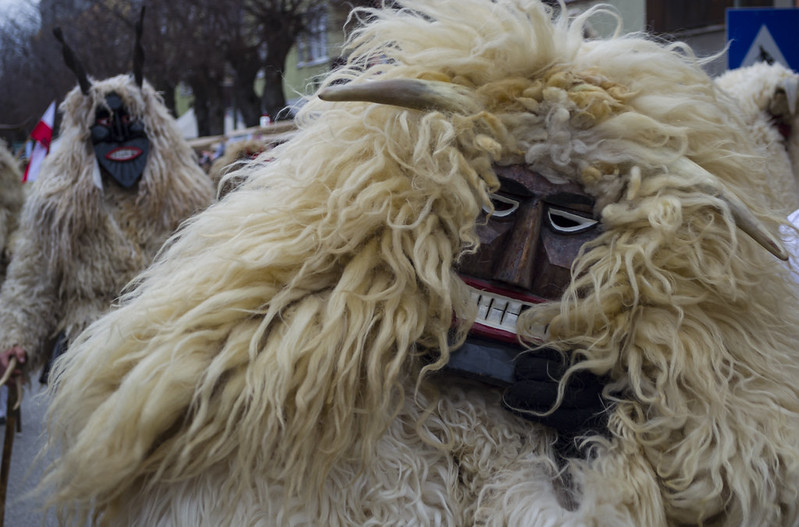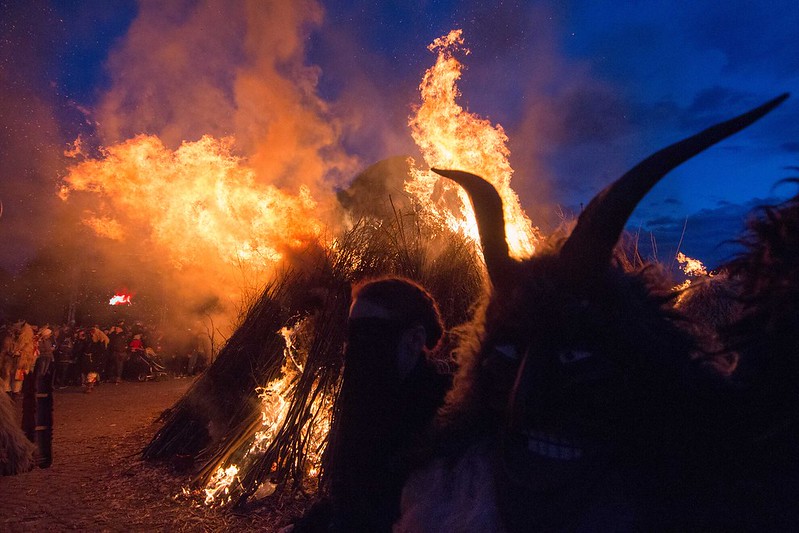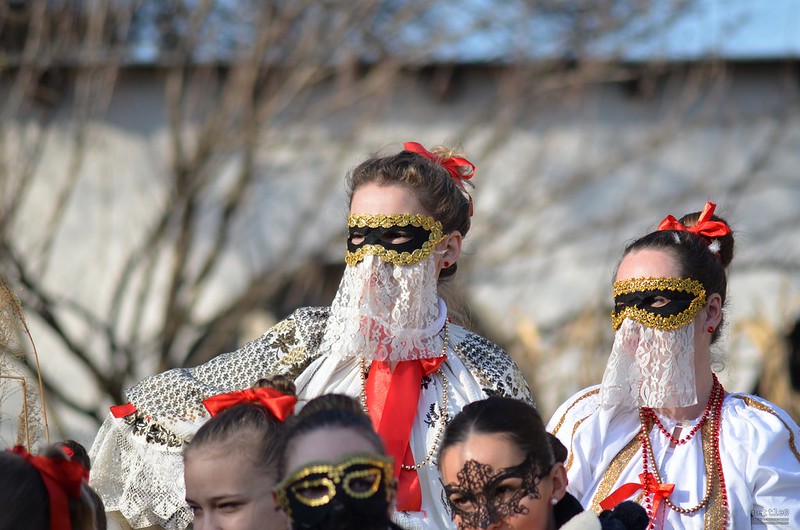Busojaras Festival
Hungary’s Festival That Chases Winter Away
2026/02/11 - 2026/02/16
Every February, the Danube riverside town of Mohács in southern Hungary is swept up in the wild energy of the Busójárás Festival. Recognized by UNESCO as Intangible Cultural Heritage, this festival features men dressed in monstrous wooden masks and sheepskin cloaks parading through the town, dancing around bonfires, and performing ancient rituals to chase away winter and welcome spring. Busójárás invites you into a world where myth and laughter collide in a truly extraordinary experience.
The clang of cowbells, the crackle of firewood, the scent of bonfires and mulled wine, the taste of spicy sausages and sweet pastries, the tactile feel of wool and carved masks... Every sense is awakened at this festival, where laughter and chaos, history and humor fill the streets.
Main Attractions
Busó Mask Parade
The main event is the Busó mask parade. “Busós” in horned wooden masks, sheepskin cloaks, and boots march through Mohács, ringing cowbells and rattling wooden clubs. The climax comes when a giant coffin effigy is burned in the main square, symbolically driving away winter and evil spirits.
Bonfires, Dancing, and Nighttime Revelry
At dusk, bonfires are lit across the town and along the riverbank. Busós and festival-goers form circles to dance, sing, and drink together. Folk music from tambura and accordion fills the air, and people of all ages join the dance. The warmth of the flames and the laughter of the crowd create a primitive yet welcoming atmosphere.
Costumes and Decorations
The Busó costumes are spectacular: hand-carved wooden masks (with large noses, fangs, horns), sheepskin cloaks, colorful sashes, and heavy boots. Many carry rattles, cowbells, or wooden clubs, and some groups arrive on decorated wagons or tractors. The whole town is adorned with banners, lanterns, and folk crafts, transforming Mohács into a living carnival.
Traditional Food & Drink
Stalls offer spicy kolbász sausages, goulash, lángos (fried bread), chimney cakes, and honey cakes. Hot wine, pálinka (fruit brandy), and tea are also popular. The aroma of grilled meat, firewood, and baked sweets fills the town, warming both body and soul.
Cultural and Historical Background
The origins of Busójárás date back to the 16th century, during the Ottoman occupation of Hungary. According to local legend, the Šokci people of Mohács, facing oppression and fear, disguised themselves in terrifying wooden masks and sheepskin cloaks, crossed the Danube on a stormy night, and returned to town. They made loud noises with rattles and cowbells to scare the Ottoman soldiers, who then fled the town. This collective act of courage and creativity became a symbol of local resistance and liberation.
Over time, the legend evolved into a ritual for driving away the darkness of winter and evil spirits, and for wishing for fertility and good fortune in spring. The dramatic elements—mask processions, bonfires, and burning of the coffin effigy—reflect both ancient pagan customs and the enduring spirit of the community.
For the people of Mohács, Busójárás is more than a spectacle. It is a rite of passage across generations, a time for family and friends to reunite, and a celebration of creativity, resilience, and local identity. Mask-making and costume preparation are passed down in families, and children learn the songs and dances of their ancestors. The festival’s blend of Hungarian, Croatian (Šokci), and other influences makes it a symbol of the region’s multiculturalism.
Recognizing its deep historical and cultural significance, Busójárás was inscribed on the UNESCO Intangible Cultural Heritage list in 2009. Today, it is one of the world’s most famous folk festivals, attracting tens of thousands of visitors each year and keeping the spirit of Mohács alive through myth, ritual, and community.
Participant Voices
I joined as a tourist and was moved by the energy and hospitality. I danced with locals, ate goulash and chimney cake, and even tried on a mask for a photo. It was wild, fun, and unforgettable! This festival is the community itself. People come from all over Hungary and abroad, and for one week, everyone becomes part of the same “wild and joyful tribe.”
Fun Facts
- “Busójárás” means “Busó-walking,” with “Busó” referring to the masked men.
- The wooden masks are traditionally hand-carved and often passed down through families.
- The burning of the coffin is a dramatic ritual to “bury winter” and call forth spring.
Festival Dates
The Busójárás Festival is held every February in Mohács, Hungary. Put on a mask, join the parade, and experience this “wild festival” where fire and folklore chase winter away.
The event schedule is subject to change. Please check the official website for the most up-to-date information.
Information
| Name | Busojaras Festival |
| Country | Hungary |
| Area | Mohacs |
| Date | 2026/02/11 - 2026/02/16 |
| Link |
Upcoming Festivals
Whirling Dervishes Festival Turkey
A Mesmerizing Dance of Divine Love
2025/12/06Mevlana Celaleddin Rumi Commemoration Ceremony ( Şeb-i Arus ) Turkey
A Whirling Journey to Divine Love
2025/12/10Dia de la Virgen de Guadalupe Mexico
A Festival Weaving Faith, Fervor, and Mexican Identity
2025/12/11L'Escalade Switzerland
Geneva’s Grand Winter Festival of Courage, Chocolate, and Community
2025/12/12Umkhosi Wokweshwama South Africa
The Zulu First Fruits Festival—A Sacred Celebration of Land, Ancestors, and Renewal
2025/12/12Lucia Festival (St. Lucia's Day) Sweden
A Festival of Light Illuminating the Nordic Darkness
2025/12/15Las Posadas Mexico
The Luminous Quest for Sacred Shelter
2025/12/22Noche de Rabanos (Night of the Radishes) Mexico
A celebration blending art, farming heritage, and cultural traditions
2025/12/23Chant of the Sybil on Majorca Spain
A Medieval Prophecy Echoes Through Majorcan Christmas
2025/12/23‘Hatajo de Negritos’ and the ‘Hatajo de Pallitas’ Peru
A Christmas Festival of Rhythm, Faith, and Afro-Andean Heritage in Peru’s Ica Region



